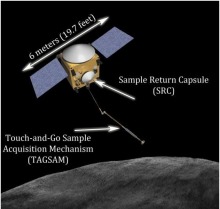There are many ways that the world could end. War, volcanoes, plagues, solar flares, etc. One disaster scenario that has gotten a lot of publicity is the possibility of a big asteroid strike that would destroy civilization. There have been attempts to catalog asteroids that regularly cross the orbit of the Earth that might pose a risk. There are a lot of that type of asteroid but the probability of any particular such asteroid striking us is very small. In addition to cataloguing suspects, there has also been a lot of speculation as to what we could possibly do if we discover that a large asteroid is headed our way. Today I am going to discuss a joint project by Canada and the U.S. to investigate a particular asteroid to try to determine whether or not it poses as significant risk.
The Origins Spectral Interpretation Resource Identification Security Regolith Explorer (OSIRIS-REx) is a United States space mission that will be the first space probe that returns samples from an asteroid. Canada will supply a critical laser based system called the Laser Altimeter at a cost of sixty million dollars. This device will be attached to the outside of the probe. It will create a high-resolution three dimensional map of the asteroid Bennu. These highly accurate maps will be used to help the mission engineers find a safe site where the probe can collect a sample. Canada will receive part of the sample that is returned to Earth as compensation for their contributions to the project.
Bennu is sixteen hundred and forty feet across. It is one of the asteroids that regularly crosses Earth's orbit and, therefore, could possibly collide with the Earth at some future date. Some researchers have calculated that there is a one in eighteen hundred chance that Bennu could hit the Earth in 2182. In order to refine the calculations, the researchers need to know the physical makeup of the asteroid. This is the question that OSIRIS-REx is intended to answer.
OSIRIS-REx will be launched in 2016. It will take two years for the probe to rendezvous with Bennu. The probe will examine the geology of the asteroid for eight months. Following the creation of the details three dimensional maps, the probe will approach the asteroid and hover a few yards above it to allow a robotic arm to reach out and scoop up a sample of asteroid material. The probe will then head for Earth with an expected recovery sometime in 2023.
The samples returned from Bennu will help researchers answer questions about the origins of the solar systems, the presence of valuable minerals and possible ways to destroying or deflecting asteroids that threaten the Earth.
Artist's conception of Bennu probe:
